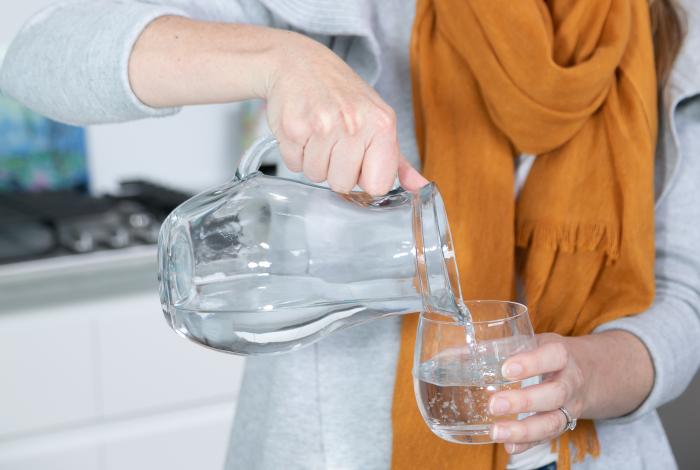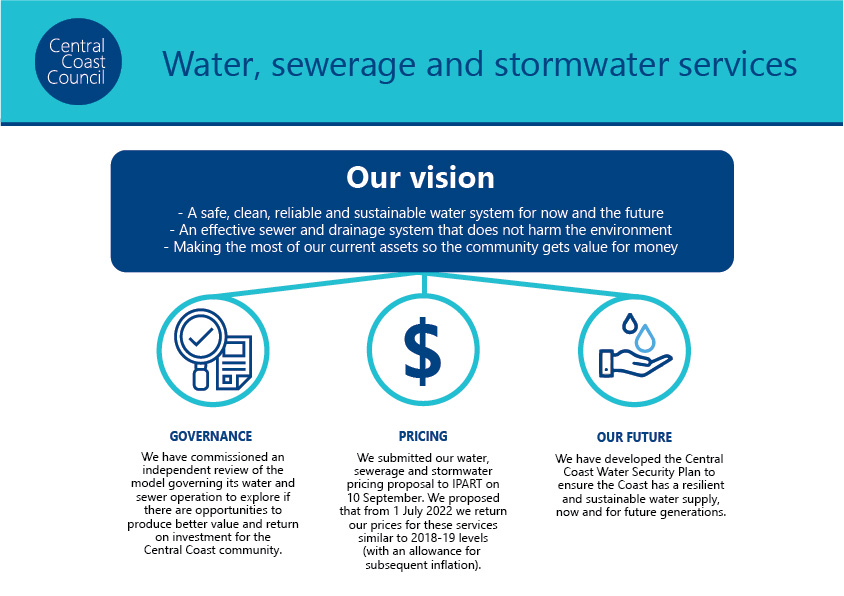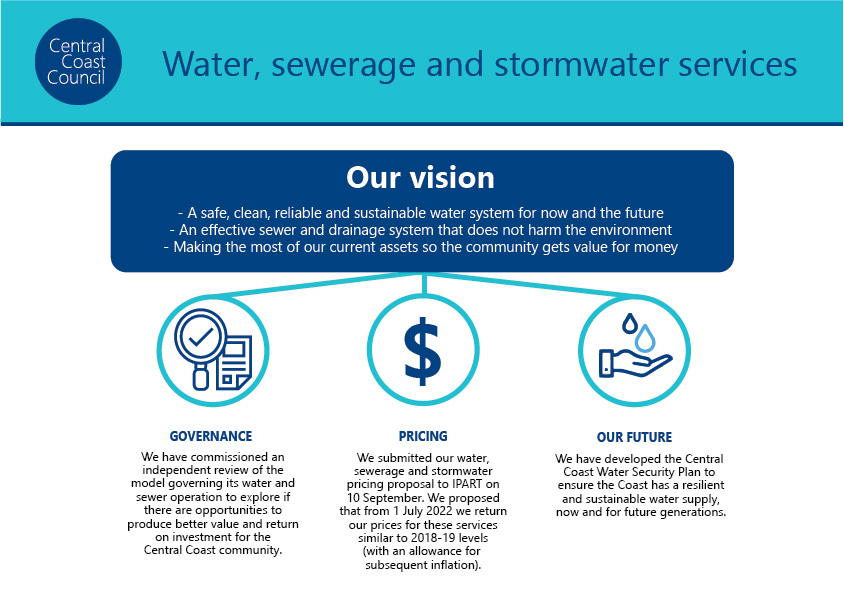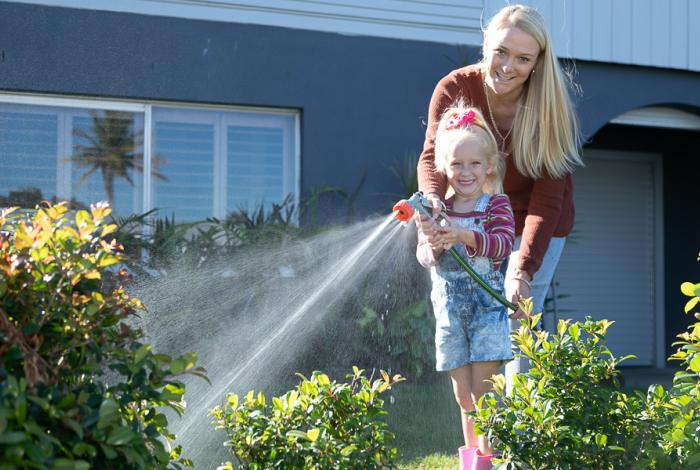Did you know your water, sewer and stormwater prices are set by the Independent Pricing and Regulatory Tribunal, also known as IPART?
On 10 September 2021 Council submitted a draft pricing proposal to IPART for its water, sewerage and stormwater drainage prices from 1 July 2022.
During IPART's review on water, sewerage and stormwater prices for the Central Coast, there were several opportunities for you to have your say:
- Between 28 September and 1 November 2021, IPART placed Council’s pricing proposal and IPART’s Issues Paper on public exhibition. Throughout the exhibition the community were invited to view the prepared documents, provide submissions to IPART and participate in a public hearing.
- Between 15 March and 14 April 2022, IPART placed the Draft Report and Determination on public exhibition. Throughout the exhibition the key considerations during the exhibition were:
- The combined yearly bill for a typical household would increase by around $200 on 1 July 2022. The bill would then increase by around $49 per year, before inflation, until 2025-26.
- Price increases would be phased in over the next four years to give customers more time to manage the impact.
- IPART has carefully balanced customer concerns about price increases with the need to ensure Council has enough funding to improve its delivery and network operations and maintain its assets.
Further information is available on IPART’s website.
Has IPART released its determination?
Yes. On 24 May 2022, IPART released its Final Report and Determination on water, sewerage and stormwater drainage pricing for the Central Coast, returning rates to levels that can see Council better maintain its vast water and sewer operations.
IPART announced it would stagger the rate changes from 1 July 2022 – 30 June 2026 to allow customers more time to manage the impacts on their bills, which was requested within the community feedback during consultation.
The pricing determination will see the combined yearly bill for a typical household increase by the following increments, plus inflation:
- 17 percent on 1 July 2022 ($183 increase)
- 6 percent in 2023-24 ($80 increase)
- 8 percent in 2024-25 ($106 increase)
- 1 percent in 2025-26 ($9 increase)
Council was required to prepare and lodge its submission on water, sewer and stormwater prices in September 2021.Due to the length of the current determination period of 3 years set by IPART it has come around a year earlier– it was not brought forward in line with Council's application to IPART for a Special Variation on rates.
Links
Segmented Documents
Timeline
Pricing
Why did Council propose an increase to my water, sewerage and stormwater drainage rates when the community survey showed a preference for lower prices?
Under the Water Management Act 2000, Central Coast Council as a Water Management Authority is deemed a monopoly service. Because of this, our prices for water, sewerage and stormwater drainage services are set by an independent body – IPART.
IPART are the NSW government regulators who conduct reviews across water, electricity, transport and local government.
Every three or four years (depending on the regulatory period set by IPART) Council is required to submit a proposal on what income is required to maintain and build water, sewerage and stormwater drainage assets. It is essentially a review to ensure that all expenditure required is both prudent and efficient.
Prior to the May 2022 determination, customers on the Central Coast had the lowest bills for water and sewerage in New South Wales, as detailed in the National Performance Report 2019-20.
A lot of Council’s assets, such as our sewage and water treatment plants and network, were built in the 1960s, and require ongoing and justifiable increases in expenditure to prevent further degradation.
Without prudent and efficient expenditure in this IPART regulatory period, Council would have risked the delivery of compliant and appropriate water, sewerage and stormwater drainage services to customers and adherence to the mandatory standards imposed by regulators.
The pricing proposal put forward by Council included increases in prices for all services:
- Water bills for residential customers would increase by approximately 40%
- Sewerage bills for former Gosford would increase by approximately 14%
- Sewerage bills for former Wyong would increase by 22%
- Stormwater drainage bills would increase by approximately 64%
The determination handed down by IPART on 24 May 2022 will see the combined yearly bill for a typical household increase by the following increments, plus inflation:
- 17 percent on 1 July 2022 ($183 increase)
- 6 percent in 2023-24 ($80 increase)
- 8 percent in 2024-25 ($106 increase)
- 1 percent in 2025-26 ($9 increase)
You can view the final IPART determination by visiting ipart.nsw.gov.au.
What was the pricing period handed down by IPART?
Council proposed that prices be set for four years (1 July 2022 – 30 June 2026). IPART supported the proposal.
When will my sewerage and stormwater drainage bill change?
On your first water notice after 1 July 2022.
What did Council propose in its application to IPART?
Council’s overall aim is to provide customers with consistent charges for the same water, sewerage and stormwater drainage services across the Coast – this is especially relevant to the sewerage service charge.
Prior to 1 July 2022, Council’s water and stormwater drainage charges aligned across both the local government areas, however the sewerage service charge was different, resulting in variances between the prices for residents and businesses in the two former local government areas (LGA).
In summary, Council proposed the following:
- Water usage price is increased to $2.25 per thousand litres (kL)
- Water service charge is increased to $238.33 per year
- Residential stormwater drainage charge is increased to $181.70 a year for a property
- Residential stormwater drainage charge is increased to $136.27 for multi premises
- Residential sewerage service charge be increased to $498.71 a year (includes a 75% discharge allowance)
- Sewerage usage charge is increased to $0.93 per kL
- Residential sewerage discharge volume is set at 125 kL per year for houses
- Residential sewerage discharge volume be set at 80 kL per year for apartments (multi premises)
- Exempt properties will continue to pay both water and sewer usage fees
- Exempt properties (land) for stormwater drainage the maximum price paid will continue to be zero
- Non-residential water service charges will be determined according to the size of the water meter
- Non-residential sewerage service charges will be determined according to the size of the meter
- Non-residential sewerage discharge volume will be based on water consumption with discharge factor applied
- Stormwater drainage charges for non-residential properties will remain on land size
Note: All prices quoted are in dollars for the year 2022-23 ($2022-23)
You can view a comparison of pre 1 July 2022 prices and proposed prices in our Plain English Summary and our pricing proposal on pages 19 and 86. When viewing these prices, remember they were the proposed prices – IPART set the maximum prices Council can charge. They issued their final determination in May 2022.
Council also proposed that:
- IPART determines Council’s charges for a four-year period from 1 July 2022 - 30 June 2026
- IPART limit annual increases in final prices for the next determination period (2022-2026) to the rate of inflation only
- Retirement villages continue to be billed as non-residential
In addition, Council proposed to reintroduce stormwater quality management into the IPART Determination with an annual investment of $3.2M per annum. At the time of the last Determination these services were funded by $25 per annum Stormwater Levy under the Local Government Act. This Levy was stopped in 2016-17 and Council proposed to simplify stormwater drainage management by consolidating all functions under the one Stormwater Drainage Charge. You can get more information on this by viewing our stormwater drainage FAQs.
How will this affect my bill? (residential customers)
Most residential customers will see their total water, sewerage and stormwater drainage bills increase after 1 July 2022.
Determining exactly how your bills may be impacted is dependent on several factors, including but not limited to the following:
- The water service charge is a fixed charge, however the water usage charge is based on how much water passes through the meter. This often depends on how many people are in the household – e.g. a larger family may use more water than a single occupant.
- The sewer service charge is a fixed charge, however the sewer usage charge is an average set by IPART as there is no sewerage meter to measure what effluent is discharged per household.
- Stormwater drainage is a set charge for residential customers and is dependent on whether you reside in a house or a multi-premise e.g. apartment
The approved pricing determination will see the combined yearly bill for a typical household increase by the following increments, plus inflation:
- 17 percent on 1 July 2022 ($183 increase)
- 6 percent in 2023-24 ($80 increase)
- 8 percent in 2024-25 ($106 increase)
- 1 percent in 2025-26 ($9 increase)
You can view the final IPART determination by visiting ipart.nsw.gov.au.
How will this affect my bill? (non-residential and businesses).
Non-residential customers will be affected in different ways depending on how much water they use, the size of the meter, if they are connected to the sewerage network, the size of their property and whether they use trade waste services.
Non-residential customers across both former local government areas will see an increase in their water service charge, water usage charge, sewerage usage charge and stormwater drainage charge.
Trade waste customers will see a small change in charges, depending on the category they fall within.
You can view the final IPART determination by visiting ipart.nsw.gov.au.
What will I get for the increases to my water, sewerage and stormwater drainage charges?
An allocation of this money will be used to deliver an accelerated program of upgrades to the water, sewerage and stormwater drainage networks throughout the Coast, including:
- The upgrade of Mardi Water Treatment Plant (MWTP), securing the original design 160ML/day plant capacity to Australian Drinking Water Guidelines. The investment is $32M.
- Water main renewals. The annual investment for priority and programmed water main renewals is $5M per year.
- Sewer Treatment Plant major upgrade in Charmhaven. The investment is $14M
- Sewer Treatment Plant upgrade in Bateau Bay. The investment is $7.8M
- Gwandalan Sewer Treatment Plant Capacity upgrade. The investment is $13.3M
You can read more about this in our pricing proposal, starting on page 36. For information on our capital investments refer to Technical Paper 4.
Stormwater drainage charge
What does the stormwater drainage charge cover?
Council owns and manages an extensive stormwater drainage network which provides a region wide benefit to all members of the community regardless of where they live. The stormwater drainage charge ensures that Council can manage the stormwater drainage infrastructure that helps connect communities and supports access to work, recreation, and essential services. This includes the provision of stormwater drainage asset management and flood planning, operations and maintenance as well as the replacement, upgrade and construction of new stormwater drainage assets.
You can view the final IPART determination by visiting ipart.nsw.gov.au.
Why did Council propose to IPART that we increase the stormwater drainage charge?
Prior to 1 July 2022 Council had the lowest water bill charges in NSW. This was partially due to IPART reducing Council’s revenue in the 2019 price determination which resulted in a significant reduction in the current stormwater drainage charge. This increase will allow Council to meet mandatory legislative standards and sustainably manage its stormwater drainage network as the infrastructure begins to age and the region continues to grow.
Council also proposed to reintroduce stormwater quality management into this IPART Determination and fund associated services using the stormwater drainage charge. At the time of the last Determination, these services were funded by a $25 per year stormwater levy under the Local Government Act. This levy was stopped in 2016-17 and Council sought to simplify the stormwater drainage management by consolidating all functions under the one stormwater drainage charge.
You can view the final IPART determination by visiting ipart.nsw.gov.au.
How much is the stormwater drainage charge increasing by?
Historically the residential stormwater drainage charge was $135 per year but this was supported by an additional stormwater levy of $25 per year. As a result of the last IPART Determination, the residential stormwater drainage charge was reduced to $110 (2022). The new charge for 2022 is $130.07 per year.
You can view the final IPART determination by visiting ipart.nsw.gov.au.
What extra services or benefits will I receive from the increase in the stormwater drainage charge?
The increase in the stormwater drainage charge will go towards achieving compliance with new dam safety regulations, improving our flood planning information and supporting proactive inspection and maintenance of critical stormwater drainage infrastructure to try and address flooding and safety issues before they occur.
The increase will also support the reintroduction of stormwater quality management including the maintenance and cleaning of stormwater quality improvement devices and urban channels across the Local Government Area.
What does this mean for you, as a community member? Overall, what you will see for the additional funds will include:
- proactive inspection and clearing of stormwater quality improvement devices – we want to reduce the amount of pollution reaching our beaches and waterways
- maintenance of urban creeks and channels – to help us manage flood risk and prevent properties from flooding
- preparation of up-to-date flood planning information – to help guide future development and plan for safe evacuations in the event of a flood emergency
- best-practice management of our declared dams – meaning the community downstream is kept safe should there ever be catastrophic dam failure
- proactive inspection, maintenance and repair of high consequence stormwater drainage infrastructure – to assist us in fixing problems before they occur and reducing the frequency of flooding over roads and private properties.
You can view the final IPART determination by visiting ipart.nsw.gov.au.
My property is located in the non-declared drainage area of the Central Coast. Will I be charged for drainage?
Properties currently located in a non-declared drainage area remain the same during the next 4-year IPART determination commencing on 1 July 2022. This means your property will continue to be charged the same as you were prior to 1 July 2022 and will not be levied the stormwater drainage charge.
You can view the final IPART determination by visiting ipart.nsw.gov.au.
Pensioners
How much is the pensioner rebate?
The current maximum rebate for pensioners across their water and sewerage services is $175 per year.
Why haven’t you increased the pensioner rebate?
The pensioner rebate for the Central Coast is set by the Water Management Act 2000.
Council’s submission expresses its support for a NSW Government review of the sufficiency and methodology for calculating water and sewerage pensioner rebates.
Why don’t you give pensioners inside retirement villages the same rebate as those in their own home?
As Council has no direct billing relationship with residents within retirement villages, pensioner rebates would have to be applied to the retirement village owners’ accounts.
The Water Management Act 2000 provides Council with no legislative provisions for applying rebates to pensioners within retirement villages.
Council’s analysis of the typical bills retirement village residents could expect shows that the majority of these residents will continue to pay less than the typical equivalent residents in a standalone home, even when a pensioner rebate is applied.
Community consultation
How could I have my say?
Council submitted their water, sewerage and stormwater pricing proposal to IPART on 10 September 2021. This pricing proposal, along with an Issues Paper from IPART, is available to view on IPART’s website.
IPART released the Draft Report and Determination on 15 March 2022. The Draft Report and Determination, along with supporting information, is available on IPART’s website.
IPART released the Final Report and Determination on 24 May 2022. The Final Report, along with supporting information, is available on IPART’s website.
Click here to be taken to IPART’s website where you can review these documents.
Information on how the community were able to get involved in available in the consultation report available in the document library on this page.
Did you consult with the community for the pricing proposal?
Yes. In developing its pricing proposal, Council considered and included input provided through its community engagement program by over 1,600 Central Coast residents through surveys, focus groups and forums.
Between 1 March and 28 March 2021 Council sought community feedback on what’s important to them about how we provide water, sewerage and stormwater drainage services. We did this through four distinct methods:
- Residential – structured: A structured (representative of the Central Coast community) survey amongst 510 residents aged 18+
- Residential – Council’s Your Voice Our Coast (YVOC) website: An opt-in online (non-representative) survey open to residents through YVOC, which resulted in 620 responses
- SME: A phone survey of 120 small to medium (SME) sized business decision makers
- Group discussions: Two qualitative group discussions amongst residents aged 18+ conducted online via Zoom
Overall, Council's IPART community engagement process identified key areas the community wants Council to focus on:
- Water quality and its reliability
- The environment
- A reduction in sewer overflows
- Maintenance of our water and sewer pipe network
- Being prompt in our response to incidents
- Keeping prices to a low and affordable level
The results of the consultation have been placed into two reports – one which summarises the results, and one which shows the results in complete detail:
General FAQs
How did our pricing proposal to IPART on water, sewerage and stormwater prices fit in with our Central Coast Water Security Plan?
Central Coast Council have developed the Central Coast Water Security Plan to ensure there is enough drinking water on the Coast now and for future generations to come.
So how does this fit into our current pricing proposal to IPART? As this plan is long-term, for the next 30 years, there are limited components in it that relate to our current IPART pricing proposal that we have submitted to IPART for the next four years. However, we proposed to IPART that the drought readiness actions and investigations to manage risks identified with Council’s preferred water supply portfolio in the draft plan be funded through revenue sought as part of the pricing determination from 1 July 2022.
As for any future pricing proposals we make to IPART for water, sewerage and stormwater drainage services – the funding models for any future supplies of water (such as desalination or purified recycled water) are yet to be determined, but it is likely to include revenue from developer charges, and available government grants, in addition to revenue we seek through water rates.
How did our pricing proposal to IPART on water, sewerage and stormwater prices fit in with the current review of Council’s water and sewer operations model?
Central Coast Council commissioned an independent review of the model governing its water and sewer operations.
This review is Council undertaking due diligence in the ordinary course of its business to explore if there are opportunities to produce better value and return on investment for the Central Coast community.
Council’s water and sewer assets are valued at close to four billion dollars. Our obligation to the community is to ensure we are maximising the value of these assets and improving efficiency and performance in how water and sewer services are delivered.
This review is about gathering and assessing all the data to get an informed view of all the possible operating structures – it is a separate process to the water, sewerage and stormwater drainage pricing proposal, which was submitted to IPART on 10 September 2021.
Any changes to Council’s water and sewer operations model that occur from the review that is taking place will be considered in future pricing proposals to IPART.
For more information on this review, please refer to the media release.
How was this pricing proposal to IPART different from the Special Variation application you submitted to IPART earlier this year? Haven’t my rates already gone up?
As a ratepayer, you receive two separate bills: your general rates and your water, sewerage and stormwater drainage rates.
Every dollar that we receive from your water, sewerage and stormwater drainage rates is treated as completely separate to Council’s other revenue streams, including your general rates.
In other words, we can only spend this set of rates on water, sewerage and stormwater drainage services such as water mains renewals, the upgrade of water and sewer treatment plants and stormwater management to ensure the ongoing health of our waterways.
In 2018, IPART set Council’s prices for water, sewerage, and stormwater drainage services for a three-year period, from 1 July 2019 to 30 June 2022, following a pricing submission made by Council. Typically, a pricing determination goes for four years, but due to the newly merged Council, IPART set it for a three-year period.
Then, earlier this year, in response to Council’s financial situation, Council successfully applied to IPART for a 15% rate rise to general rates, to help with Council’s financial recovery. This process is called a Special Variation (SV) application and is a one-off application. This application was for general rates only, and did not include your water, sewerage and stormwater drainage rates. You can read more FAQs about the SV here.
On 10 September 2021, Council submitted their latest pricing proposal to IPART for the period commencing 1 July 2022. This pricing proposal was submitted due to the timing set by IPART. It was not brought forward in line with the SV.
Why was a new IPART water pricing submission made just three years after the last one in 2018? Is this the normal frequency and if not why the sudden change in frequency?
In 2018, IPART set Council’s prices for water, sewerage and stormwater drainage services for a three-year period, from 1 July 2019 to 30 June 2022, following a pricing submission made by Council. Typically, a pricing determination goes for four years, however IPART set it for a three-year period due to the newly merged Council. Council’s submissions are now back on the normal four year cycle.
Council’s next pricing submission was due for lodgement with IPART in September 2021 and will determine Council’s prices for those services from 1 July 2022 until 30 June 2026.
For Council to prepare the pricing proposal to IPART, a rigorous process was undertaken where business cases for expenditure needed to be completed as well as asset management plans and community consultation.
Once the pricing submission is sent to IPART (September 2021) it will be another 9 months before price changes are implemented, which brings us to 1 July 2022.
The fact that Council are preparing the proposal now is due to the timing set by IPART. It has not been brought forward in line with the Special Variation application submitted to IPART by Council as part of its Business Recovery Plan.



